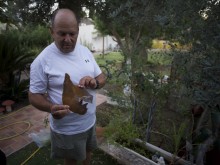Washington Post Ventures from Gaza to Cover Israel

News coverage of Operation Protective Edge mainly focused on casualties in the Gaza Strip, missiles launched at Israel and tunnels built by Hamas. There was comparatively little attention to the lives and hardships of Israelis, especially those who resided close to Gaza. So The Washington Post’s feature “I want to come back but, I’m afraid” (Aug. 14, 2014) was a noteworthy gesture toward balance.
The article commented that “[f[or the past month, ‘frontline communities’ such as Nahal Oz and a neighboring kibbutz, Kfar Aza, resembled ghost towns. Most residents fled what had become a combat zone, with Israeli artillery whooshing above them and Gaza rockets flying the other way, sometimes landing on rooftops or in gardens and schoolhouses.”
After Hamas took over the Gaza Strip in 2006, the southern Israeli town of Sderot and nearby kibbutzim have endured a rain of mortars and rockets that was under-reported by news media. Despite Israel’s complete withdrawal from Gaza in 2005, Palestinian complaints of “Israeli occupation” and Israel’s “siege” (a partial blockade aimed at limiting importation of material useful to Hamas and other terrorist groups) tended to draw the bulk of news reporting.
Without better balanced coverage, audiences don’t learn what life has been like on the Israeli side of the armistice line or the reasons for military operations conducted by Israel. (CAMERA has noted previous examples of more comprehensive coverage such as “Exhibit A: USA Today’s Well-Balanced Gaza Reporting”, July 15, 2014).
The Post ’s feature helped make real to readers the experiences of Israelis near Gaza. “People are so tired of living as refugees in their own country,” said Noam Stahl, 47, a plastics consultant and resident of Kfar Aza who was born and raised in the kibbutz.
The Post showed how Palestinian terror attacks affected the residents of Israel’s south wherever they were in their own country:
“Residents patiently answer questions about why they don’t move somewhere safer, as if it were so obvious it needs no explanation. Where in Israel is safe?
“‘In Tel Aviv, five years ago, people were afraid if they got on a bus it would explode,’ Stahl said. ‘Jerusalem was the same. At Kiryat Shmona in the north, for 15 years they had Katyusha rockets come at them from Lebanon. If I decide it’s no longer safe to live here, if I take my family and move elsewhere in Israel, who can guarantee we won’t be the target of a terrorist attack in our new home?’”
Stahl depicts Israel’s situation as it is. Israel bashers sometimes falsely describe the Gaza Strip as an “open air prison”. Such loaded language would not accurately describe Israel but the Jewish State is surrounded by countries and terrorist groups who have been seeking its destruction and since its inception in 1948. Perhaps more media attention to this enduring hostility and its effects on Israelis, less uncritical attention to Palestinian grievances and claims of Israeli oppression would help readers understand the conflict.
The Post’s “I want to comeback, but I’m afraid,” accurately described the situation for many residents of southern Israel . In doing so it informed readers of another side to the Arab-Israeli conflict—better, the Arab-Islamic conflict with Israel—too little discussed: the impact on Israelis. Other media outlets should take note. — Ziv Kaufman
More from SNAPSHOTS
Reuters Falsely Links Jerusalem Embassy, Two-State Solution
January 9, 2019
The Jerusalem office park which houses Guatemala's embassy Multiple recent Reuters articles incorrectly report that moving the Brazilian embassy from Tel Aviv to Jerusalem is a dramatic move away from the two-state solution. For instance, [...]
American Lutheran In Jerusalem Affirms that IDF Soldiers Are “Stormtroopers,” Backtracks
December 19, 2018
Rev. Carrie Ballenger Smith is a pastor at the Church of the Redeemer in Jerusalem. She ministers to the English-speaking congregation that meets at the Lutheran church, which is located in the Old City of [...]
The Washington Post Ignores Antisemitic Attack in Los Angeles
November 29, 2018
The Washington Post has warned about a “rising tide of antisemitism.” But as CAMERA has highlighted, The Post’s coverage of antisemitism has frequently been selective and is often politicized. More recently, the newspaper even ignored [...]
Think Tank: Iran Was Closer to Building a Bomb Than Previously Thought
November 23, 2018
A Nov. 20, 2018 report by a Washington D.C.-based think tank, the Institute for Science and International Security (ISIS) argues that Iran’s illegal nuclear weapons program was “more advanced than Western intelligence agencies and the [...]
AFP Headline Casts Palestinian Assailant as Victim
November 21, 2018
Agence France Presse yesterday published a throwback headline, bringing us back to the period almost two years ago in which media outlets serially produced headlines which depicted Palestinian attackers as the victims. The wire agency's [...]
More Hypocrisy and Anti-Semitism From Linda Sarsour
November 19, 2018
In an earlier CAMERA exposé, we pointed out the self-serving allegiances and disgraceful hypocrisy of Linda Sarsour (of Women's March fame). We demonstrated how she poses as a universal activist who embraces all marginalized people [...]
Small Steps: Improved NY Times Language on Target of Hamas Rockets
November 15, 2018
Earlier this week, we pointed out how a New York Times article about fighting between Israel and Hamas neglected to inform readers that Palestinian rockets were fired indiscriminately toward civilians in Israeli towns and cities. [...]


